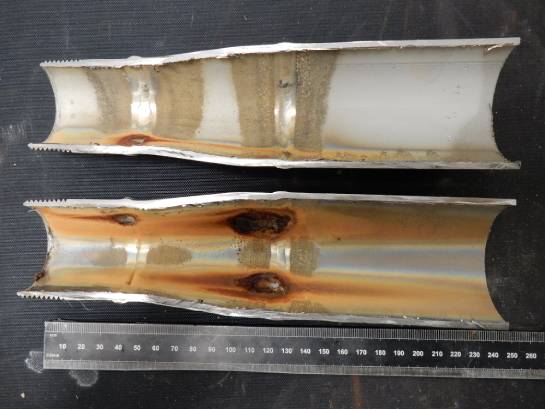Failure analysis and replica investigation
Changes in material structure and eventual failure are issues that every company has to deal with. Whether it is rather on the utilities side (such as cooling water or steam), or on the process side, it is important to identify degradation or failure in time and investigate the cause thoroughly. Only then can the right measures be taken to prevent further degradation or failure.
FAILURE ANALYSIS
Installations, devices or pipelines fail for many reasons. To take the right measures it is necessary to know the root cause of failure. This can be done by means of a failure analysis by which we select the right techniques to get to the real cause of failure.
A failure analysis typically starts with a visual examination of the failed component. We study the morphology of the deterioration, possibly take a sample of the deposit/corrosion products for analysis by SEM-EDX and/or FTIR spectroscopy, and select a zone or several zones for cross-sectional examination.
Fracture surfaces are examined by SEM microscopy. If microbiologically influenced corrosion (MIC) is suspected, specific tests are performed for that as well.
Our experts compile the results of the various investigations and formulate a root cause as well as recommendations to prevent failure in the future.
Benefits of failure analysis:
- Knowledge of the actual root cause of failure.
- Advice on how to prevent failure in the future.

REPLICA INVESTIGATION
Materials are subject to numerous exposure conditions. As a result, the material structure (microstructure) and thus the material properties may change. To examine the condition of a material on site, we can perform a replica investigation. This involves taking an impression of the microstructure to check, among other things, whether:
- Phase changes or precipitations have occurred in the material;
- The material exhibits creep damage;
- The material contains microcracks.
Before an impression of the microstructure is taken, the surface is lightly sanded and polished. The structure is then etched and an impression taken. Since only a very thin surface layer is removed, the technique is almost non-destructive. After an impression has been taken, it is further examined using a light microscope. The entire examination can take place on the spot so that you can obtain immediate results.
Benefits of replica investigation:
- Quasi non-destructive;
- Rapid technique, immediate results;
- Knowledge of material condition and presence or absence of microdefects.






